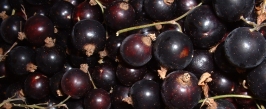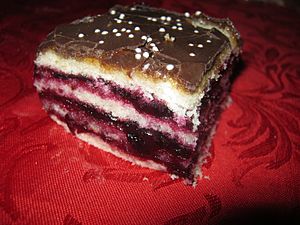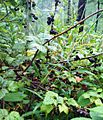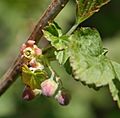Blackcurrant facts for kids
Quick facts for kids Blackcurrant |
|
|---|---|
 |
|
| Scientific classification | |
| Kingdom: | |
| Division: | |
| Class: | |
| Order: | |
| Family: |
Grossulariaceae
|
| Genus: | |
| Species: |
R. nigrum
|
| Binomial name | |
| Ribes nigrum |
|
The blackcurrant (Ribes nigrum) is a small, dark-colored fruit. It has a strong, tart taste. You can find blackcurrants growing in central and northern Europe and northern Asia.
These berries are packed with lots of vitamin C. Their name comes from their dark color. Blackcurrants are used to make many yummy things. These include jelly, ice cream, and cordial. In the United Kingdom, blackcurrant is a very popular flavor. People also use blackcurrants in salads and for baking, much like raisins.
Contents
History of Blackcurrants

Blackcurrants originally grew in northern Europe and Asia. People in Russia started growing them around the 11th century. They were found in monastery gardens and in towns. In other parts of Europe, people began growing them more widely in the late 1600s. Long ago, people also used blackcurrant leaves, bark, or roots as traditional medicines.
Blackcurrants During World War II
During World War II, it was hard to get fruits rich in vitamin C. Fruits like oranges were scarce in the United Kingdom. Blackcurrant berries have a lot of vitamin C. Also, blackcurrant plants grow well in the UK climate. Because of this, the British Government encouraged people to grow more blackcurrants. The amount of fruit grown in the country grew a lot.
Starting in 1942, blackcurrant syrup was given for free to children under two years old. This might be why blackcurrant flavor is still so popular in Britain today. Today, most blackcurrants in Britain are grown by machines. About 1,400 hectares (about 3,460 acres) of the fruit are grown. Most of these go to companies that make juice. In Eastern Europe, many blackcurrants are grown for juice and juice concentrate.
Blackcurrants in the United States
Blackcurrants were once popular in the United States. However, they became less common in the 1900s. This happened because growing currants was banned in the early 1900s. Blackcurrants could carry a disease called white pine blister rust. This disease was a threat to the U.S. logging industry.
The federal ban on growing currants changed in 1966. States could then decide for themselves. In New York State, the ban was lifted in 2003. This was thanks to a plant expert named Greg Quinn. Now, growing currants is making a comeback in states like New York, Vermont, and Oregon. But some states, like Maine and Ohio, still have bans.
Because of this ban, many people in the United States don't know about blackcurrants. They are not as popular there as they are in Europe or New Zealand. However, blackcurrants are becoming more known again. They have a unique flavor and are full of good things like fiber and important nutrients. More products with blackcurrant are now appearing in the U.S. market.
How Blackcurrants Are Used
Culinary Uses
You can eat blackcurrant fruit raw, but it has a very strong, tart taste. They are often made into jams and jellies. These set easily because the fruit has a lot of pectin and acid. For cooking, the fruit is usually cooked with sugar. This makes a smooth purée. This purée can then be strained to get the juice.
The purée can be used to make blackcurrant preserves. It can also be added to cheesecakes, yogurt, ice cream, desserts, and sorbets. The very strong flavor can be made milder by mixing it with other fruits. For example, you can combine it with raspberries and strawberries in summer pudding. Or you can mix it with apples in crumbles and pies. The juice can be used in syrups and cordials. Blackcurrants are also a common part of Rødgrød. This is a popular dessert in North German and Danish cuisines.
Blackcurrants are also used in savory cooking. Their tartness adds flavor to many sauces, meat, and other dishes. They are even used in some unusual food combinations. You can add them to tomato and mint for a salad. They can go with roast or grilled lamb. They are also used with seafood and shellfish. Some people use them as a dipping sauce for barbecues. They can be mixed with mayonnaise. Blackcurrants can even brighten up bananas and other tropical fruits. They are also combined with dark chocolate or added to mincemeat in traditional mince pies at Christmas.
Japan buys a lot of blackcurrants from New Zealand. They use them for dietary supplements and snacks. They are also used in special healthy foods. Quick-frozen blackcurrants are used to make jams or preserves.
Blackcurrant Drinks
Blackcurrant juice is used to make many popular drinks. These include cordials, juice drinks, and smoothies. It is often mixed with apple or other red fruits. It can also be blended with pomegranate and grape juice. Crushed blackcurrants are also the main ingredient in a liqueur called crème de cassis. This liqueur is added to white wine to make a Kir. If you add it to champagne, it makes a Kir Royale.
In the United Kingdom, blackcurrant cordial is often mixed with cider (hard cider). This drink is called "cider and black." If it's mixed with common British lager beer, it's called a "lager and black." Adding blackcurrant to a mix of cider and lager makes a drink called "diesel" or "snakebite and black." You can find these at pubs. A "black 'n' black" is made by adding a little blackcurrant juice to a pint of stout. The foam on top turns purple if the juice is put in the glass first. Blackcurrant juice is sometimes mixed with whey for an energy drink.
In Russia, blackcurrant leaves can flavor tea or preserves. They are used in salted cucumbers. The berries are used for making homemade wine. Sweetened vodka can also be flavored with blackcurrant leaves. This makes a greenish-yellow drink with a tart taste. The berries can be used in a similar way. In Britain, 95% of the blackcurrants grown are used in Ribena. Ribena is a brand of fruit juice. Its name comes from Ribes nigrum.
Images for kids
-
Green currant is a type of blackcurrant grown in Finland. Its berries are not dark and have almost no strong smell. This type is called 'Vertti'.
-
Willem Claesz. Heda: The Blackcurrant Pie (1641), Musée des Beaux-Arts de Strasbourg
See also
 In Spanish: Casis para niños
In Spanish: Casis para niños








